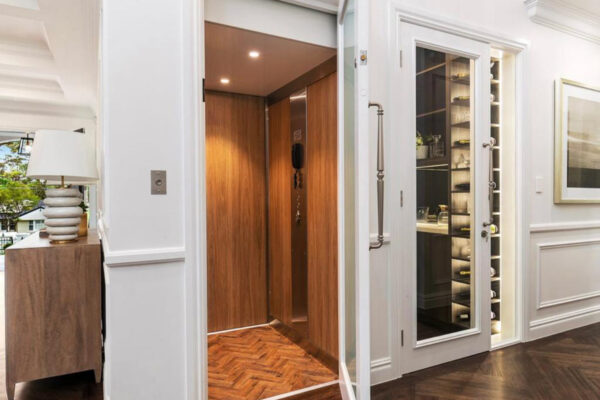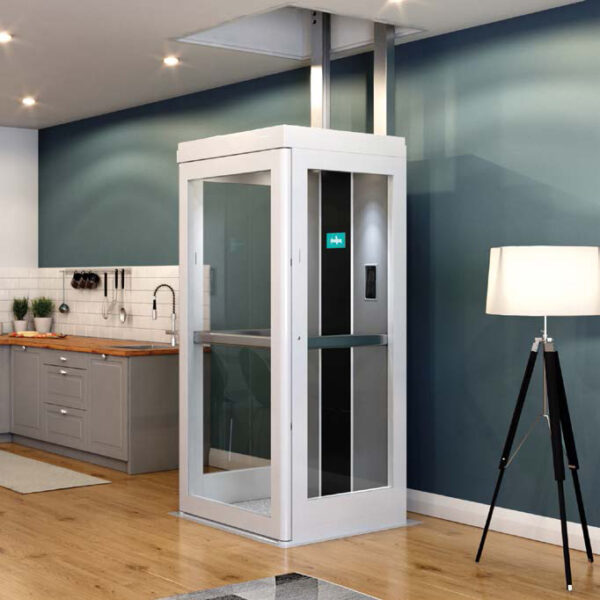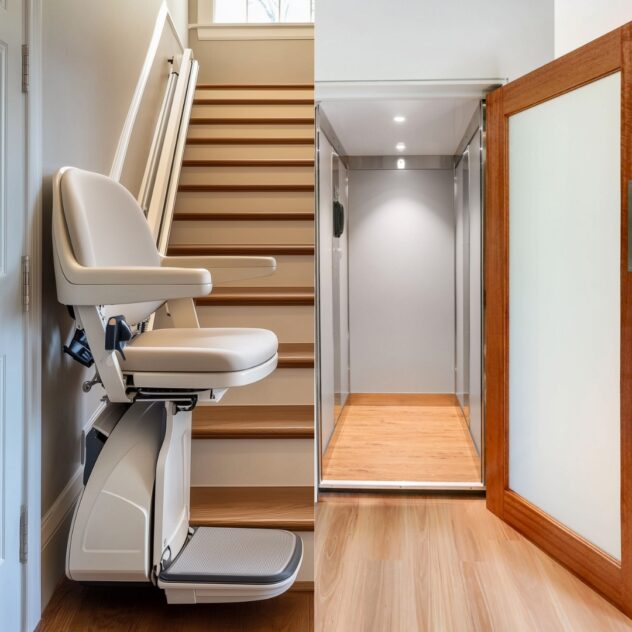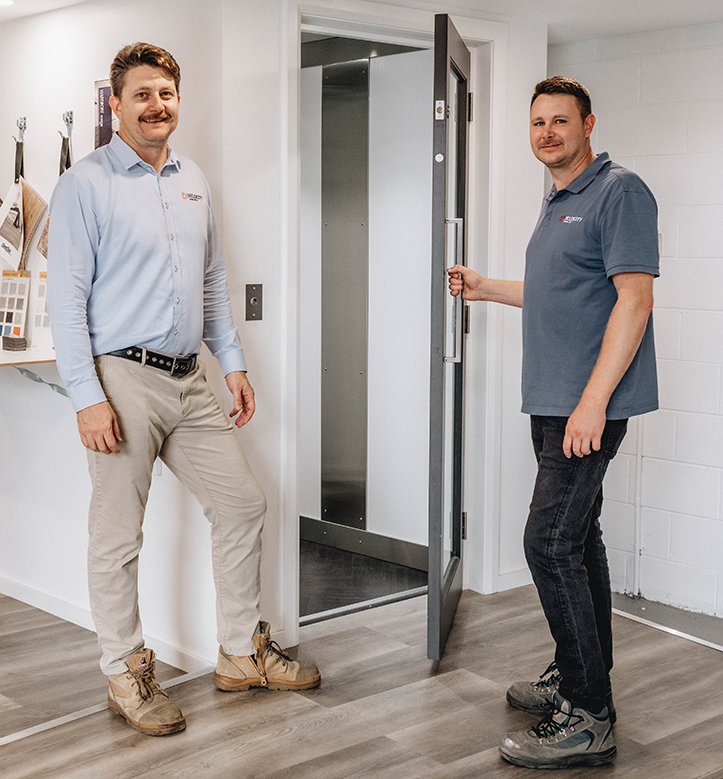Making your multi-level home more accessible is a significant decision that impacts both daily life and property value. While both home elevators and stair lifts can enhance mobility, they offer different benefits and suit different situations. Understanding these differences is crucial for making the right choice for your home and lifestyle.
As homes in Australia continue to embrace multi-level living, particularly in areas like Sydney’s Northern Beaches and North Shore, the need for practical mobility solutions has grown. Whether you’re planning ahead or addressing immediate needs, understanding your options is the first step toward making an informed decision.
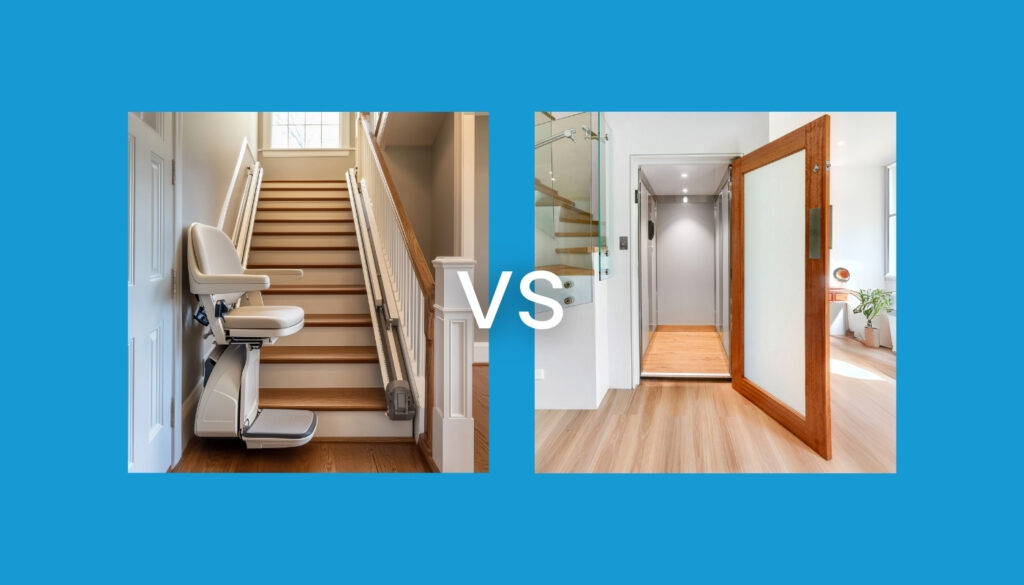
Understanding Your Options
Home Elevators
Modern home elevators have evolved significantly, becoming more compact and easier to install than ever before. These vertical transport solutions can be retrofitted into existing homes or incorporated into new builds, offering a permanent solution that enhances both accessibility and property value.
Electric vs Hydraulic Home Elevators
When considering a home elevator, it’s important to understand the two main types of drive systems:
Electric Home Elevators:
- Energy efficient operation
- Lower maintenance requirements
- Smaller footprint with no machine room needed
- Quieter operation
- More environmentally friendly
- Consistent, smooth ride quality
- Ideal for residential applications
- Lower running costs
Hydraulic Systems:
- Typically used in commercial applications
- Require more space for hydraulic equipment
- Higher maintenance needs
- More expensive to operate
- Potential for oil leaks
- Generally louder operation
Modern electric home elevators come in various styles:
- Shaft-based systems for new constructions
- Self-supporting units for retrofitting
- Compact solutions for smaller spaces
- Luxury options with premium finishes
Electric home elevators serve multiple users and can transport both people and items between floors, making them a versatile addition to any home.
Stair Lifts
Stair lifts provide a simpler solution, consisting of a motorised chair that travels along a rail mounted to your staircase. They’re available in various configurations:
- Straight stair lifts for standard staircases
- Curved models for stairs with landings or turns
- Standing platforms for those who can’t easily sit
- Outdoor versions for external stairs
While typically designed for single-person use, stair lifts can be a practical solution for those who primarily need help navigating stairs.
Comparing Key Factors
Initial Investment
When considering mobility solutions for your home, understanding the financial implications of each option is crucial for making an informed decision. While the initial investment varies significantly between electric home elevators and stair lifts, it’s important to consider both the upfront costs and long-term value each option provides.
Electric home elevators represent a larger upfront investment, typically ranging from $35,000 to $60,000 depending on configuration and features. While this may be more than hydraulic systems initially, the lower maintenance and running costs often make them more economical over time. They add significant value to your property and provide a long-term solution for the entire household.
Stair lifts generally cost between $4,000 and $12,000, with curved installations being more expensive. While more affordable initially, they may need replacement sooner and don’t add comparable property value.
Installation Requirements
The installation process and requirements for each mobility solution can significantly impact your decision, particularly when considering timing and disruption to your home. Understanding what’s involved helps set realistic expectations and ensures proper planning.
Home Elevators:
- Require dedicated space (though less than many expect)
- May need some structural modifications
- Installation typically takes 2-4 days
- Can be retrofitted or included in new builds
- Professional installation required
Stair Lifts:
- Minimal space requirements
- Usually no structural changes needed
- Installation often completed in one day
- Can be removed if no longer needed
- May impact stair use for others
Property Value Impact
When investing in home improvements, understanding the impact on your property’s value is essential. While both options provide mobility solutions, their effect on home value and marketability differs substantially.
Home elevators typically offer significant return on investment:
- Add measurable property value
- Attract a wider range of potential buyers
- Enhance property marketability
- Provide architectural interest
- Future-proof the home
Stair lifts, while practical, generally:
- Don’t add significant property value
- May need removal for resale
- Have minimal aesthetic appeal
- Serve a more temporary purpose
Functionality & Use
Day-to-day functionality is perhaps the most important consideration when choosing between an electric home elevator and a stair lift. Each solution offers different capabilities that can significantly impact your daily routine and quality of life.
Home Elevators:
- Transport multiple people
- Carry furniture and heavy items
- Serve all family members
- Enhance general household logistics
- Provide stable, smooth operation
- Support aging in place
Stair Lifts:
- Single-person transport
- Limited to personal mobility
- May slow stair access for others
- Require user to transfer on/off
- Meet immediate mobility needs
Maintenance & Longevity
Understanding the long-term maintenance requirements and expected lifespan of your mobility solution helps you make a more informed decision about your investment. Regular maintenance is crucial for ensuring safe operation and maximising the longevity of either option.
Home Elevators:
- 20+ year lifespan with proper maintenance
- Annual professional servicing required
- Parts readily available
- Comprehensive warranty options
- Regular safety inspections needed
Stair Lifts:
- 7-10 year average lifespan
- Less intensive maintenance
- Battery replacement needed
- Limited warranty coverage
- Simpler mechanical system
Choosing the Right Solution
Selecting between a home elevator and a stair lift is a decision that requires careful consideration of your current needs, future requirements, and overall home setup. While both options can improve mobility, their suitability varies significantly depending on your specific circumstances. Understanding which solution best matches your situation can help ensure long-term satisfaction with your investment.
When to Consider a Stair Lift
For some homeowners, a stair lift presents a practical immediate solution to mobility challenges. These systems are particularly suitable when budget constraints are a primary concern or when the need may be temporary. However, it’s important to consider whether this shorter-term solution aligns with your long-term plans.
- Immediate mobility needs
- Budget constraints
- Temporary solution needed
- Single user requirement
- Straight, simple staircase
- Rental property situations
When to Consider a Home Elevator
Electric home elevators represent a more comprehensive solution that serves both immediate needs and future requirements. While they require a larger initial investment, they offer significant advantages in terms of functionality, property value, and long-term utility. These systems are particularly valuable when considering the needs of multiple family members and the overall convenience they bring to daily life.
- Long-term planning
- Multiple users
- Property value consideration
- New construction
- Whole-family benefit desired
- Regular transport of items between floors
Future Planning Considerations
Making the right choice requires looking beyond immediate needs to consider how your requirements might evolve over time. Many homeowners find that while a stair lift might meet their current needs, an electric home elevator provides a more comprehensive solution that adapts to changing circumstances and growing families. Consider not just your current situation but how your needs might change in the coming years.
Think about:
- Expected length of home ownership
- Family growth plans
- Aging considerations
- Resale timing
- Budget over time
- Changing mobility needs
Making Your Decision
Consider these key questions:
- What’s your timeline for installation?
- How many people need to use it?
- What’s your budget both short and long term?
- How long do you plan to stay in your home?
- What’s the impact on other family members?
Professional Assessment Recommendations
Before making your final decision:
- Arrange site assessments
- Get detailed quotes
- Review warranty options
- Discuss maintenance requirements
- Consider future needs
Next Steps
Once you’ve decided which solution best suits your needs:
- Get multiple quotes
- Check installer credentials
- Review warranty details
- Plan installation timing
- Prepare your home
For expert guidance, you can either:
- Consult with an NDIS-registered access consultant
- Speak directly with our experienced team at Velocity Home Lifts
The Verdict: Why Home Elevators Lead the Way
When comparing mobility solutions, electric home elevators emerge as the superior choice for most situations. A direct comparison highlights the key differences:
| Feature | Electric Home Elevator | Stair Lift |
|---|---|---|
| Capacity | Multiple people + items | Single person only |
| Property Value | Significant increase | Minimal to none |
| Installation | Professional, permanent solution | Temporary attachment |
| Usage | Entire household benefit | Limited to one user at a time |
| Aesthetics | Enhances home design | Impacts staircase appearance |
| Durability | 20+ year lifespan | 7-10 year lifespan |
| Functionality | Multi-purpose use | Single-purpose |
| Future Planning | Adapts to changing needs | May need replacement |
While stair lifts can serve as useful temporary solutions, home elevators offer comprehensive benefits that extend far beyond basic mobility:
Freedom and Independence
- Unrestricted movement between floors for all family members
- No need to transfer from mobility devices
- Independent use without assistance
- Dignity and comfort in your own home
Long-Term Value
- Significant increase in property value
- Lower lifetime costs through durability
- Reduced maintenance requirements
- Energy-efficient operation
Practical Benefits
- Transport groceries, laundry, and heavy items
- Accommodate future mobility needs
- Support aging in place
- Benefit the entire household
Quality of Life
- Preserve your home’s aesthetic appeal
- Maintain full use of your staircase
- Enjoy quiet, smooth operation
- Add a premium feature to your home
While the initial investment in a home elevator is higher, the long-term benefits make it the clear choice for homeowners looking to enhance their quality of life while adding value to their property. An electric home elevator provides a permanent, elegant solution that grows with your family’s needs while offering independence and freedom throughout your home.
Contact our team to discuss how a home elevator could transform your living space and enhance your lifestyle.
This comparison provides general information to help in your decision-making process. Specific requirements and costs may vary based on your location and needs.

